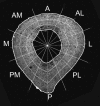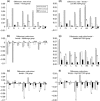Regional variation of intracortical porosity in the midshaft of the human femur: age and sex differences
- PMID: 15730477
- PMCID: PMC1571459
- DOI: 10.1111/j.1469-7580.2005.00384.x
Regional variation of intracortical porosity in the midshaft of the human femur: age and sex differences
Abstract
This study investigated age and sex differences in patterns of porosity distribution in the midshaft of the human femur. Cross-sections were obtained from 168 individuals from a modern Australian population. The sample comprised 73 females and 95 males, aged between 20 and 97 years. Microradiographs were made of 100-microm sections and pore and bone areas were determined using image processing software. Initially the sample was divided by age: young (20-44 years), middle (45-64 years) and old (65+ years), but it was found that analysis on the basis of the ratio of medullary area to total subperiosteal area gave clearer results. The cortex was divided into three rings radially and into octants circumferentially and the porosity of each segment was calculated. Results showed that a pattern with raised porosity in the posterior and anterolateral regions, and with greater porosity in the inner parts of the cortex, becomes more pronounced with age. In males this pattern develops steadily; in females there are much greater differences between the middle and older groups than earlier in life. The patterns observed are consistent with progressive bone loss occurring along a neutral axis of the cortex where bending stress is lowest and the mechanical advantage of the bone is least.
Figures




Similar articles
-
Increase in pore area, and not pore density, is the main determinant in the development of porosity in human cortical bone.J Anat. 2006 Aug;209(2):219-30. doi: 10.1111/j.1469-7580.2006.00589.x. J Anat. 2006. PMID: 16879600 Free PMC article.
-
Age-related changes in cortical porosity of the midshaft of the human femur.J Anat. 1997 Oct;191 ( Pt 3)(Pt 3):407-16. doi: 10.1046/j.1469-7580.1997.19130407.x. J Anat. 1997. PMID: 9418997 Free PMC article.
-
Spatial variation in osteon population density at the human femoral midshaft: histomorphometric adaptations to habitual load environment.J Anat. 2016 May;228(5):733-45. doi: 10.1111/joa.12433. Epub 2015 Dec 28. J Anat. 2016. PMID: 26708961 Free PMC article.
-
Computational anatomy in the study of bone structure.Curr Osteoporos Rep. 2013 Sep;11(3):237-45. doi: 10.1007/s11914-013-0148-1. Curr Osteoporos Rep. 2013. PMID: 23722733 Review.
-
Reduced bone formation and increased bone resorption: rational targets for the treatment of osteoporosis.Osteoporos Int. 2003;14 Suppl 3:S2-8. doi: 10.1007/s00198-002-1340-9. Epub 2003 Mar 19. Osteoporos Int. 2003. PMID: 12730770 Review.
Cited by
-
External bone size identifies different strength-decline trajectories for the male human femora.J Struct Biol. 2020 Dec 1;212(3):107650. doi: 10.1016/j.jsb.2020.107650. Epub 2020 Oct 21. J Struct Biol. 2020. PMID: 33096230 Free PMC article.
-
Cortical bone development, maintenance and porosity: genetic alterations in humans and mice influencing chondrocytes, osteoclasts, osteoblasts and osteocytes.Cell Mol Life Sci. 2021 Aug;78(15):5755-5773. doi: 10.1007/s00018-021-03884-w. Epub 2021 Jul 1. Cell Mol Life Sci. 2021. PMID: 34196732 Free PMC article. Review.
-
Advances in assessment of bone porosity, permeability and interstitial fluid flow.J Biomech. 2013 Jan 18;46(2):253-65. doi: 10.1016/j.jbiomech.2012.10.025. Epub 2012 Nov 19. J Biomech. 2013. PMID: 23174418 Free PMC article. Review.
-
Divergent mechanical properties of older human male femora reveal unique combinations of morphological and compositional traits contributing to low strength.Bone. 2022 Oct;163:116481. doi: 10.1016/j.bone.2022.116481. Epub 2022 Jul 9. Bone. 2022. PMID: 35817317 Free PMC article.
-
Region-specific associations among tissue-level mechanical properties, porosity, and composition in human male femora.J Biomech. 2022 Jun;139:111144. doi: 10.1016/j.jbiomech.2022.111144. Epub 2022 May 20. J Biomech. 2022. PMID: 35623287 Free PMC article.
References
-
- Ahlqvist M, Damsten O. A modification of Kerley's method for the microscopic determination of age in human bone. J. Forensic Sci. 1969;14:205–212. - PubMed
-
- Atkinson PJ. Changes in resorption spaces in femoral cortical bone with age. J. Path. Bacteriol. 1965;89:173–178. - PubMed
-
- Baer MJ. Growth and Maturation. an Introduction to Physical Development. Cambridge, MA: Howard A Doyle; 1977.
-
- Bell KL, Loveridge N, Power J, et al. Structure of the femoral neck in hip fracture: Cortical bone loss in the inferoanterior to superoposterior axis. J. Bone Miner Res. 1999a;14:111–119. - PubMed
-
- Bell KL, Loveridge N, Power J, Garrahan N, Meggitt BF, Reeve J. Regional differences in cortical porosity in the fractured femoral neck. Bone. 1999b;24:57–64. - PubMed
MeSH terms
LinkOut - more resources
Full Text Sources
Medical

